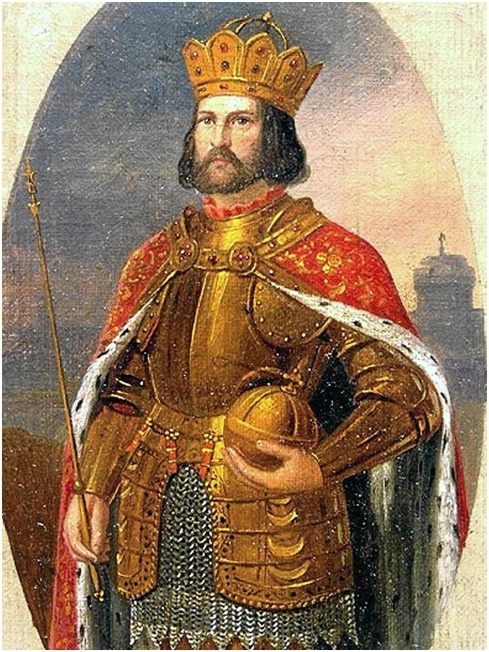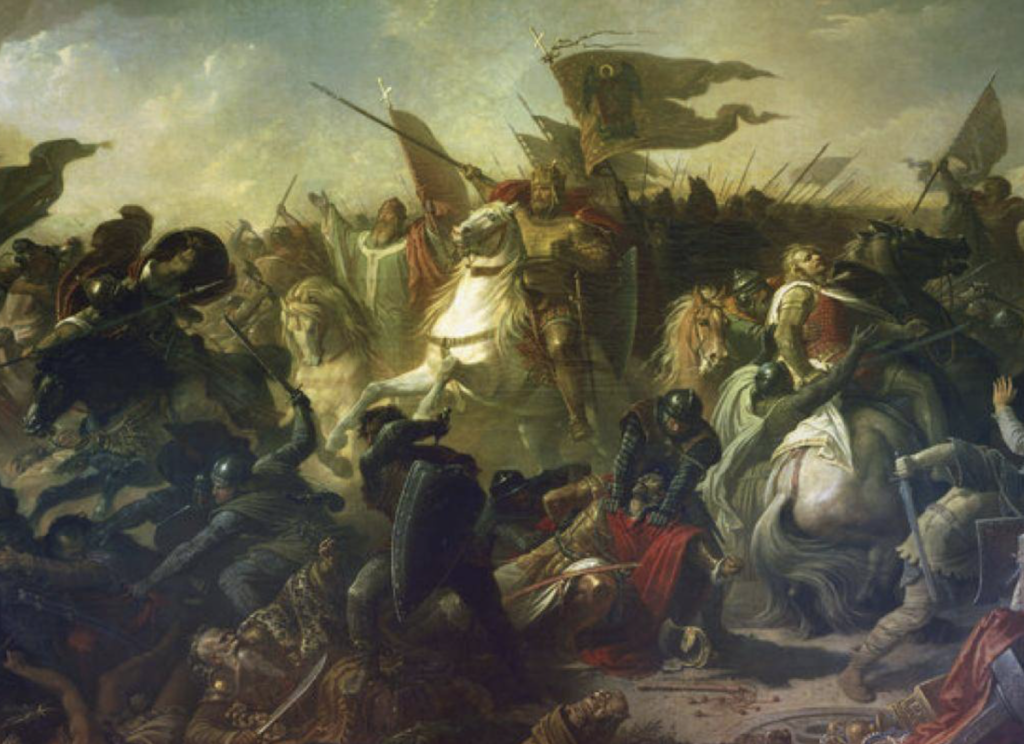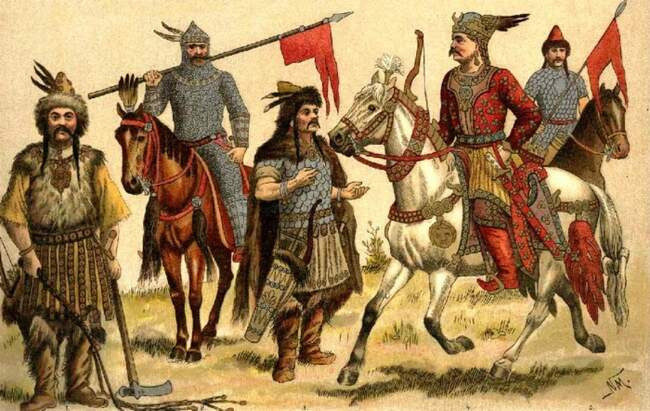The Hungarians, also called Magyars, were the only representatives of the Finno-Ugrians who moved from the forest zone to the steppe zone. It is supposed that the reason for such migration of Protovengrians to the south was very intensive swamping of their originally ethnic territories. And it turned out that in Europe they were completely alien both in language and way of life — in the sprawling steppe Carpathian region, where the Hungarians came, they moved from semi-nomadic to full nomadic pastoralism. Living in nomadic groups, they were always on the lookout for new pastures.
But nomads need cloth, metalwork, all the things their neighbors had, so the Hungarians were attracted to rich and not densely populated areas that were poorly defended. Excellent horsemen, like all nomads, the Hungarians were swift — their light cavalry would strike quickly and roll back when repulsed. A contemporary who lived in Italy in 904 wrote: «Before us are cities without citizens and fields without farmers, the plains are white from the dry bones of the dead».
For Europe of the X century Hungarians were the same as Horde for Russia of the XIII century — an eternal threat and irresistible force.
It was with the Hungarians faced Otto I, later called the Great (912 — 973), Duke of Saxony, who continued the policy of his father to unite all the Germanic tribes in a single state.

Otto the Great
Battle on the river Lech 955.
Having received information that the Hungarians had besieged Augsburg, Otto led his troops on an accelerated march to the rescue of the brave townspeople, gathering on the way vassals and allies.
The king brought to the river Lech in Bavaria about 10 thousand heavily armed soldiers, but the Hungarians, according to the chronicler, were much more, so the king gathered all the barons, counts, who led the squads and troops of vassals, to convey the main message: you can win only with the strictest discipline and complete obedience. Then he addressed the soldiers: «They outnumber us. I know their numbers well, but they have neither our courage nor our weapons. They can count only on courage, and we can count on the hope and protection of Heaven. It would be a shame to surrender to the enemy……. But we would rather continue the conversation with sword than tongue!»
The battle began with an apparent setback: some of the Hungarians stealthily maneuvered and attacked the Germans’ wagon, the Hungarians joyfully began to plunder (the eternal dream of a cavalryman: an enemy wagon full of such necessary and diverse goods!), but Otton with an iron hand suppressed the cries of «We are surrounded!» — and sent his Saxons to cut down the marauders scattered among the tents and carts, and himself led the heavy cavalry on the main Hungarian forces.
The Hungarians unleashed a shower of arrows at the attacking Germans. But alas, the Hungarian arrows could not penetrate the excellent armor and shields of the German heavy cavalry. The German units did not disturb the order, mindful of their small numbers. The second volley of arrows did not happen: the German cavalry descended on the Hungarian hordes and broke through the Hungarian order, which immediately scattered into separate pockets, but what can scattered groups of lightly armed riders do against the armored cavalry!

Otton leads the way to victory
Encouraged by Otton’s vigorous commands, the Germans persistently pursued and cut down the fugitives, some of whom tried to swim across the river, but the current was very rough and the fugitives drowned.
Captured Hungarians were not only executed by the Germans — the survivors had their noses and ears cut off and were sent home in this form.
After such a terrible defeat Hungarians no longer dared to invade the western countries, and the king, famous for his grandiose triumph, was declared by the troops the father of the army and the Emperor — so the Holy Roman Empire arose, and the victory over the pagan Magyars brought Otto’s reputation as the savior of the Christian world and consolidated his power.
Let’s emphasize: heavy European cavalry faced the light cavalry of nomads, who covered the enemy with arrows, but the knights’ cavalry in heavy armor, obeying the orders of the experienced and tough king, continued to fight and defeated the superior forces of the enemy.
The Battle of Legnica in 1241.
There is a sincere belief that there were no Mongols (Tatars, Horde) at all, they never attacked Russia and especially Europe, and there was this:
1. Feudal wars;
2. Civil war;
3. Massacres of those still resisting acceptance of Christianity;
4. Invasion from the East East Siberian core of super ethnos Russ, because «Mongols» on Russia was not. It is the myth created in Vatican with the purpose of distortion of true history — in the West do not wish to recognize strategic defeat from Russ-Horde Empire. Russia and Horde have stopped centuries-old offensive of the West — «onslaught to the East»;
5. War Russ-pagans of Asia with Russ-Christians of fragmented Vladimir-Suzdal and Kiev Russia.
Meanwhile, Europe, through the mouths of chroniclers, kings and barons, envoys of the Pope and his bulls, firmly, persistently and confidently spoke about the invasion of an unknown people: «…a certain unknown barbarian tribe, called Tartars or Ismailis, came out of its borders. They have made the greatest extermination of people, especially Christians, to pursuit of which and eradication of their name they aspired».
Could these unknowns have been Russian regiments?
European rulers are well acquainted with Russian warriors: the tradition of dynastic marriages with representatives of European ruling houses began with Yaroslav the Wise — he gave his daughters to European rulers or their heirs, his sons married brides from Europe. The Russian embassy traveled all over Europe preparing the wedding of Anna Yaroslavna and Henry Capeting. Gita, the daughter of King Harold Godwinson, became the wife of Vladimir Monomakh, and Vladimir himself, at the request of Polish King Boleslav, makes a campaign with a Russian squadron to Bohemia, besieges the city of Brno and receives a ransom of one thousand hryvnias.
Polish prince Boleslav has taken direct part in Russian feud, having supported Svyatopolk and even having occupied for some time Kiev.
So Europe knew Russian warriors and princes well and hardly confused them with «descendants from Tartarus», that is why Henry the Pious — the owner of one of the most powerful principalities of Poland, Silesia — was preparing to meet some «unknown pagans».

Henry leaves Legnica. Artist Jae Matejko
Henry’s allies approached the town of Legnica in Silesia: warriors were brought by the Czech King Wenceslas, the warrior brothers of the Teutonic Order, the Templars and groups of mercenaries and volunteers, professional warriors of course.
We will designate their opponents in quotation marks, so as not to argue: «Mongols».
Their head, Baidar, had 1,000 archers to harass and lure the enemy, 11,000 mounted archers, and 8,000 heavy cavalry. In all, his army was estimated at nearly 20,000 men. Henry and his allies could counter this with 8 thousand heavy cavalry, 3 thousand light cavalry, 14 thousand infantrymen, that is quantitatively the forces of the opponents are equal.
Apparently, the Europeans planned to repel the enemy attacks with their light cavalry, bleed him, and then deliver a crushing blow to the heavy knight cavalry.
The opponents met on April 9, 1241.
The situation is standard: the light cavalry fires at the knights, all the time keeping the distance, Henry throws the knights into the attack, who fall into the «carousel» of mounted riflemen, showering them with arrows, and then there is something incomprehensible: on the way of the knights’ avalanche there are puffs of smoke (have they set fire to dry grass? laid out fires? ignited some «Chinese special compositions», as one of the historians wrote?), all this thwarted the knights’ rush, and then the heavy cavalry of the Mongols struck. In addition, as the Polish medieval historian Jan Dlugosz wrote, the soldiers of one of the Mongol units began shouting in Polish, «Run, run!». This caused a commotion among the Poles: some thought it was an order, and some realized that it was useless to resist and rushed away, dragging the others with them. Confusion, flight, collision with their own infantry … total rout.

Henry’s head is shown to the inhabitants of Legnica. Figure from the chronicle
Henry’s head is shown to the inhabitants of Legnica and demanded surrender, but the townspeople decided to resist and the Mongols left.
Compare: Otto in 955 faced the cavalry of the nomadic Hungarians, who were famous for their excellent archery, but the energetic warlord king rallied the knights’ cavalry with iron discipline, achieved complete obedience and led the heavy knights’ cavalry through the archers’ arrows, defeating the Magyar nomads.
Henry in 1241 assembled a knightly army that was pelted with arrows by «Mongols», lightly armed horsemen like the Hungarians, but his heavy cavalry could not resist the «Mongols», succumbed to panic and suffered heavy losses in flight.
What, the armor of the XIII century was much worse than the armor of the X century? Hungarians could not penetrate them and did not defeat the Germans, and «Mongols» easily shot Polish knights and their allies?
Or Otton, a bright, strong-willed personality (charismatic — it is not by chance that he created the First Reich!), managed to enthuse his Germans with confidence in victory! But Henry the Pious could not do it — it is not the weapon that wins, but the man with the weapon.
